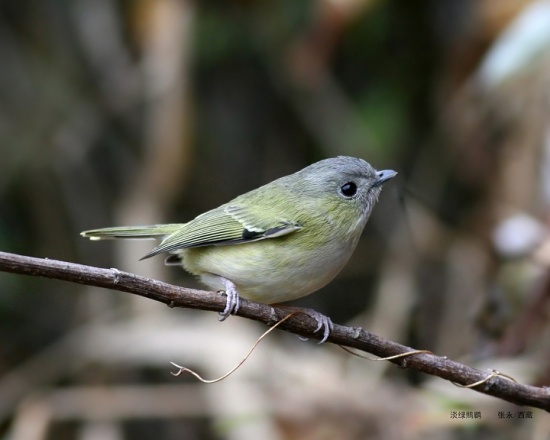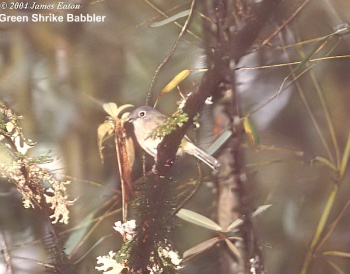(References updated) |
(Imp size. References updated) |
||
| Line 2: | Line 2: | ||
;[[:Category:Pteruthius|Pteruthius]] xanthochlorus | ;[[:Category:Pteruthius|Pteruthius]] xanthochlorus | ||
==Identification== | ==Identification== | ||
| − | 12 - 13cm. A small Shrike-Babbler with a relatively small bill. Rather nondescript: | + | 12 - 13cm (4¾-5 in). A small Shrike-Babbler with a relatively small bill. Rather nondescript: |
* Stocky, rounded head with small stubby bill | * Stocky, rounded head with small stubby bill | ||
* Greenish-olive above with grey cap | * Greenish-olive above with grey cap | ||
| Line 11: | Line 11: | ||
* ''Pallidus'' shows a whitish eyering | * ''Pallidus'' shows a whitish eyering | ||
Juveniles as females but more olive-washed above and more yellowish underparts. | Juveniles as females but more olive-washed above and more yellowish underparts. | ||
| − | [[Image:Green_Shrike-Babbler.jpg|thumb|350px|right|ssp ''pallidus'' with whitish eyering<br />Photo by {{user|James+Eaton|James Eaton}}<br>Wolong, Sichuan, [[China]], June 2004]] | + | [[Image:Green_Shrike-Babbler.jpg|thumb|350px|right|ssp ''pallidus'' with whitish eyering<br />Photo by {{user|James+Eaton|James Eaton}}<br>Wolong, Sichuan, [[China]], June 2004 <!--EDITORS: this image is not in the Gallery-->]] |
==Distribution== | ==Distribution== | ||
Found from northeast [[Pakistan]] east along the [[Himalayas]] to [[India]], [[Nepal]], [[Bhutan]] and adjacent [[Tibet]]. Also in northern [[Burma]] and locally in South [[China]] east to Fujian.<br /> | Found from northeast [[Pakistan]] east along the [[Himalayas]] to [[India]], [[Nepal]], [[Bhutan]] and adjacent [[Tibet]]. Also in northern [[Burma]] and locally in South [[China]] east to Fujian.<br /> | ||
Locally common in its range. | Locally common in its range. | ||
==Taxonomy== | ==Taxonomy== | ||
| + | ====Subspecies==== | ||
Four subspecies described<sup>[[#References|[1]]]</sup>: | Four subspecies described<sup>[[#References|[1]]]</sup>: | ||
*''P. x. occidentalis'': | *''P. x. occidentalis'': | ||
| Line 37: | Line 38: | ||
Resident species. | Resident species. | ||
==References== | ==References== | ||
| − | #{{Ref- | + | #{{Ref-Clements6thAug16}}#{{Ref-HBWVol12}}#{{Ref-RasmussenAnderton05}} |
{{ref}} | {{ref}} | ||
==External Links== | ==External Links== | ||
{{GSearch|Pteruthius+xanthochlorus}} | {{GSearch|Pteruthius+xanthochlorus}} | ||
[[Category:Birds]] [[Category:Pteruthius]] | [[Category:Birds]] [[Category:Pteruthius]] | ||
Latest revision as of 22:39, 21 November 2016
- Pteruthius xanthochlorus
Identification
12 - 13cm (4¾-5 in). A small Shrike-Babbler with a relatively small bill. Rather nondescript:
- Stocky, rounded head with small stubby bill
- Greenish-olive above with grey cap
- Whitish below with pale yellowish belly and vent
- Washed yellow-olive breast-sides and flanks
- Single wing-bar white to yellowish-white
- Male with darker grey cap, female with paler and more brown-tinged cap
- Pallidus shows a whitish eyering
Juveniles as females but more olive-washed above and more yellowish underparts.
Distribution
Found from northeast Pakistan east along the Himalayas to India, Nepal, Bhutan and adjacent Tibet. Also in northern Burma and locally in South China east to Fujian.
Locally common in its range.
Taxonomy
Subspecies
Four subspecies described[1]:
- P. x. occidentalis:
- P. x. xanthochlorus:
- P. x. hybrida:
- Assam (Lushai and Naga Hills) to western Myanmar (Chin Hills)
- P. x. pallidus:
- North-eastern Myanmar to south-western Qinghai, western Sichuan, Yunnan and north-western Fujian
Habitat
Temperate broadleaf forest and conifer forest. Found at 210 - 3600m in India, at 900 - 3600m in China.
Behaviour
Diet
Feeds on beetles, ants and other insects, takes also berries and seeds.
Usually seen singly, in pairs or small groups of up to 4 birds, often in mixed flocks with other species like tits, leaf-warblers or other babblers. A strictly arboreal species with a sluggish behaviour like the Vireos.
Breeding
Breeding season from April to August. The nest is a deep purse or cradle, made of fine root fibres and lichen or moss. It's suspended 1.5 - 8m above the ground like a hammock from a branch of a tree. Lays 2 - 4 eggs.
Movements
Resident species.
References
- Clements, J. F., T. S. Schulenberg, M. J. Iliff, D. Roberson, T. A. Fredericks, B. L. Sullivan, and C. L. Wood. 2016. The eBird/Clements checklist of birds of the world: v2016, with updates to August 2016. Downloaded from http://www.birds.cornell.edu/clementschecklist/download/
- Del Hoyo, J, A Elliott, and D Christie, eds. 2007. Handbook of the Birds of the World. Volume 12: Picathartes to Tits and Chickadees. Barcelona: Lynx Edicions. ISBN 978-8496553422
- Rasmussen, PC and JC Anderton. 2005. Birds of South Asia: The Ripley Guide. Barcelona: Lynx Edicions. ISBN 978-8487334672
Recommended Citation
- BirdForum Opus contributors. (2024) Green Shrike-Babbler. In: BirdForum, the forum for wild birds and birding. Retrieved 25 April 2024 from https://www.birdforum.net/opus/Green_Shrike-Babbler





